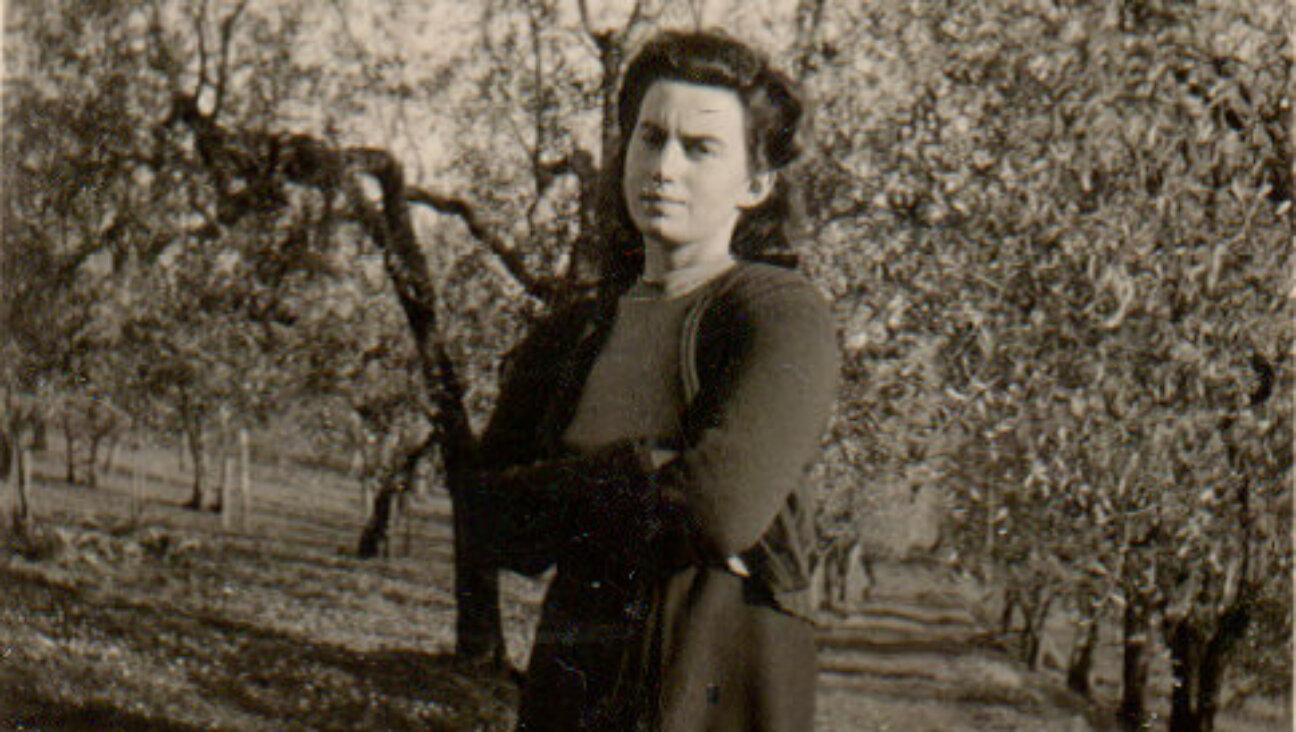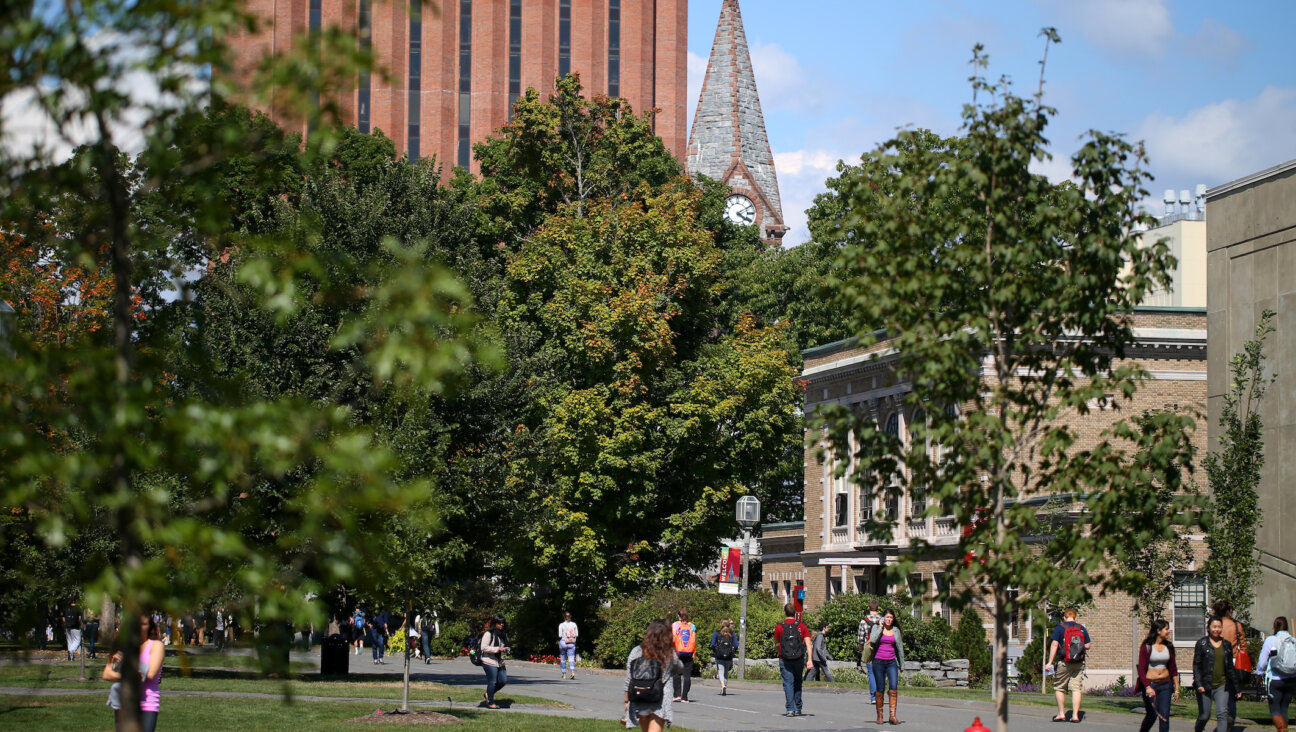Little Girl’s Affliction Sparks Flowering of Creativity
In the close-knit community of Greenmeadow, Calif., a 2-year-old girl diagnosed with a rare Jewish genetic disease cannot talk, but her spirit speaks loudly enough to touch many people beyond her neighborhood.
There is no cure for the disease afflicting Sophia Herzog-Sachs, who was diagnosed with Niemann-Pick Type A in early 2002 and whose life expectancy is only three years. Even so, her parents, Richard Sachs and Karen Herzog-Sachs, are committed to helping others who face similar challenges. A foundation they started, Sophia’s Garden, has become the incubator of a number of projects that seek to harness the arts to help Sophia and other children with deadly genetic diseases.
Niemann-Pick Type A is caused by a genetic mutation and results in a build up of a fatty substance, sphingomyelin, in the spleen, liver and bone marrow. Type A, one of four subtypes, is the fatal form prevalent among Ashkenazi Jews and is one of the two subtypes that affect the brain.
One project created for Sophia by a friend of the Sachses, composer Herb Moore, is an album of 11 short compositions of a type he calls “genetic music.” Moore got the idea for “genetic music” from a friend and spent the past year writing music for Sophia’s Garden, the first of what he calls his “genetic series.” To create the music, he used the properly functioning gene that is mutated in Sophia’s case and correlated each molecule of the DNA sequence with different sounds. By combining the sounds and varying the tempo, Moore created slow, soothing melodies. The 11-track album is also called “Sophia’s Garden.”
“For me the end result is the music and the spirit of the music rather than the technical underpinning,” he said.
Moore brought over each track he recorded for Richard and Karen to play for Sophia, since he wanted to create music that would relax Sophia in the same way as his gentle guitar strumming did.
“Sophia really liked it and so did we. It kind of became a soundtrack for what we are doing, very calming and supportive,” Richard said.
“Herb just happened to show up with the sound therapy for Sophia. She really loved it and so did we. She could sleep to his music,” Karen said.
In the last track of the album, “Of Sophia’s Song,” Moore used recordings of Sophia’s vocalizations.
“Musically her voice is magical,” said Karen, who recalled Moore saying, “She has perfect pitch. She can barely talk, but she’s got perfect pitch.”
Half of the sales from the “Sophia’s Garden” album are going to her foundation. Moore plans on promoting his music by offering it as “an invitation for people to listen to and in some way connect with the spirit of Sophia’s community.”
A dance project directed by Judith Komoroske, a choreographer, might soon spin off of Moore’s album and possibly feature props portraying the intricate process of genetic expression. “The arts are to help us make sense out of life,” Komoroske said.
On a recent trip Karen, Richard and Sophia took to the East Coast, they brought Moore’s album with them when they met with the director of neurosciences at Genzyme, a drug company. He was so moved by Sophia, the first Niemann-Pick A child he ever met, and inspired by hearing Moore’s CD that he ordered copies for his whole staff.
A neighbor of the Sachses, Robin Modlin, has started a “prayer flag” project for Sophia, modeled after a program at Lucille Packard Children’s Hospital in Palo Alto, Calif. Participants have decorated colorful flags with prayers for Sophia. According to a Tibetan tradition, when the flags fly, they send the prayers all over the world in the wind. The flags decorate Karen and Richard’s living room.
“It’s created an environment where Karen and Richard feel like they’re surrounded by all these people and their good wishes,” Modlin said.
Another friend is bringing a prayer flag to Sofia, Bulgaria, this summer.
Coining the term the “Sophia effect” to describe the community’s reaction to the little girl, Modlin said he thinks that Sophia is “like a muse for people in their creativity.”
The Jewish community also helps the Sachses by preparing them daily meals. “We have four different Jewish congregations from Reform to Orthodox helping us, bringing us meals, which is very unique in one community. They’re all sharing e-mails trying to figure out who’s going to do what, when,” Karen said.
The foundation’s Web site, sophiasgarden.org, features a “circle of healing” for Sophia that combines all these creative projects with treatments from both Western and Eastern medicine and foods from their own organic garden.
“Without one of these links our lives would be very, very difficult,” Richard said.
Karen and Richard hope to eventually expand their foundation and “pay it forward” to other families like their own.
“We’re looking at doing more outreach in terms of genetic testing, but mostly for Ashkenazi Jewish diseases,” Karen said.
The couple did go through preliminary genetic testing before their pregnancy, but they were not tested for Niemann-Pick A, which many hospitals, especially those in areas without a large Jewish population, do not offer in their standard basket of tests for Ashkenazi Jews. Karen and Richard are working to initiate a policy requiring doctors to tell patients about all genetic tests, even those that are not offered at their institutions.
The flourishing community that has formed around Sophia leaves onlookers awestruck and fascinates participants like Moore. “This is really one of the best things that we humans can do for each other,” Moore said. “To offer something to somebody else’s life that at least for a moment makes it a little more bearable.”
“It’s been an enormously powerful experience and I wouldn’t change anything about it. She is such a wonderful person. I’m really glad to have had the opportunity to know her. Our lives are forever changed by her and enriched,” Karen said.
“As are probably a thousand other people that have been touched and are thanking us all the time for Sophia,” Richard added.
The Forward is free to read, but it isn’t free to produce

I hope you appreciated this article. Before you go, I’d like to ask you to please support the Forward.
Now more than ever, American Jews need independent news they can trust, with reporting driven by truth, not ideology. We serve you, not any ideological agenda.
At a time when other newsrooms are closing or cutting back, the Forward has removed its paywall and invested additional resources to report on the ground from Israel and around the U.S. on the impact of the war, rising antisemitism and polarized discourse.
This is a great time to support independent Jewish journalism you rely on. Make a gift today!
— Rachel Fishman Feddersen, Publisher and CEO
Support our mission to tell the Jewish story fully and fairly.
Most Popular
- 1

Fast Forward Ye debuts ‘Heil Hitler’ music video that includes a sample of a Hitler speech
- 2

Opinion It looks like Israel totally underestimated Trump
- 3

Culture Cardinals are Catholic, not Jewish — so why do they all wear yarmulkes?
- 4

Fast Forward Student suspended for ‘F— the Jews’ video defends himself on antisemitic podcast
In Case You Missed It
-

Culture How one Jewish woman fought the Nazis — and helped found a new Italian republic
-

Opinion It looks like Israel totally underestimated Trump
-

Fast Forward Betar ‘almost exclusively triggered’ former student’s detention, judge says
-

Fast Forward ‘Honey, he’s had enough of you’: Trump’s Middle East moves increasingly appear to sideline Israel
-
Shop the Forward Store
100% of profits support our journalism
Republish This Story
Please read before republishing
We’re happy to make this story available to republish for free, unless it originated with JTA, Haaretz or another publication (as indicated on the article) and as long as you follow our guidelines.
You must comply with the following:
- Credit the Forward
- Retain our pixel
- Preserve our canonical link in Google search
- Add a noindex tag in Google search
See our full guidelines for more information, and this guide for detail about canonical URLs.
To republish, copy the HTML by clicking on the yellow button to the right; it includes our tracking pixel, all paragraph styles and hyperlinks, the author byline and credit to the Forward. It does not include images; to avoid copyright violations, you must add them manually, following our guidelines. Please email us at [email protected], subject line “republish,” with any questions or to let us know what stories you’re picking up.














